Almirante Barroso and Tamandaré were the last cruisers of Brazil. Both were acquired in 1951 as the ex-Brooklyn class USS Philadelphia and USS St Louis. They were upgraded electronics wise before transfer under MDAP to Brazil with the latest radars and were further modernized in 1960s with SPS-10, SPS-12 radars while keeping their 1945 AA artillery almost intact. They differed between them, Tamandaré being commissioned later after further superstructures, turrets and masts alterations and Barroso lost her conning tower. Tamandaré took part in the absurd “lobster war” of 1961-63 and standoff with the French Navy in 1971. Barroso was discarded in 1973 and Tamandaré in 1980, sooner than their Chilean and Argentinian counterparts (O’Higgins and Belgrano class).
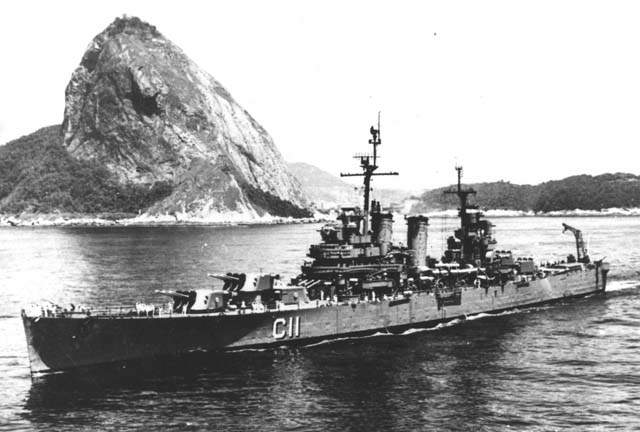
Acquisition
In 1951, the fear of a new arms race between South American traditional naval powers, Brazil, Argentina and Chile, led to a plan to simply transfer to these countries, financed under MDAP six prewar ex-Brooklyn class cruisers, now considered surplus to requirement. The thinking was that if all three had the exact same ships were possessed by the three rivals, a kind of deterrent balance would be created, thus avoiding any new naval arms race, that plagued their economies in the past. After all three were important economic partners to the US and part of continent still under the monroe doctrine. The sale for each was around 30+ million dollars, more than their scrap value despite the financial help of the MDAP, but the true reasons were that the US feared the activity of Soviet cruisers (the Sverdlov class in particular) in South American waters. The sale became a hedge against the concern of a hypothetical action of these cruisers acting commerce raiders.
The Brazilian authorities still also hoped at that time to maintain naval superiority in South America through and valued their “special relationship” with the United States. No doubt they were disappointed as the white house played a balance of power policy and also sold pairs of Brooklyn-class cruisers to Argentina and Chile. All obsolete at the time they became the “ABC cruisers”.
A post will be made soon covering the Chilean O’Higgins class was well.
Contracts were signed in 1951 but not all cruisers were transferred or commissioned at the same time. In the case of Argentina, these were the Belgrano class, and in the Case of Chile, the O’Higgins class. Contracts were signed in January 1951 with the Brazilian government, as the same time as the transfers to Chile, whereas it lingered until December for Argentina. Barroso was the ex-USS Philadelphia, initially laid down on 28 May 1935 at Philadelphia Navy Yard, launched on 17 November 1936 and commissioned on 23 September 1937. In WW2 she operated on the European theater, notably the Mediterranean until 1945. She was awarded 5 battle stars. She made two “magic carpet” runs postwar and was not supposed to be kept in service past 1947, so she was decommissioned in the Philadelphia Navy Yard on 3 February and kept in the mothballs, until stricken the dau of her transfer on 9 January, the exact same date as the Chilean cruisers.
Under the name of Almirante Barroso as commissioned 21 August 1951, she started a new career as C-11 until her decommission and being stricken by May 1973.
On her side, USS Saint Louis (CL-49) was laid down at Newport News on 10 Dec. 1936, launched on 15 April 1938 and commissioned on 19 May 1939. She served in the Pacific (Pearl Harbor, TF 17 raid, Salomons campaign, Coral Sea, Kula Gulf, Kolombangara, Tulagi, Mariana-Palau, Philippines, Ryukyu campaign, earning 11 battle stars). She was decomissioned on 20 de june 1946 and mothballed, then officially trabsferred on 9 January but not recommissioned before August 1952 (some sources states 29 January 1951). As Almirante Tamandaré (C-12) she was decommissioned on 28 July 1976 so three years after her sister and was sold for BU later, then sank under tow to the contracted shipbreaker.
Design of the class
Hull and general design
Specifications as the same as the Brooklyn class cruiser, so for details, design orrigins and pecularities, check it out. To be brief and concise, these were essentially 1930 London treay cruisers, the signatory US having “filled” its quota of heavy cruisers (defined by their caliber gun, 203 mm or 8 inches), thse were still large ships, 10,000t standard, so the maximum authorized under the treaties, and yet considered as “light cruisers” due to their use of light guns, 6 inches or 152 mm. But given their size, they were shoehorned with no less than five triple rapid-fire gun turrets. Their AA was considerably augmented in WW2, and was quite impressive by 1945 between secondary 5-inches guns, 40 mm and 20 mm AA guns, plus modern radars and fire control systems.
They measured as transferred a bit differently. Both were 182.9 meters or 600 feet long at the waterline for 185.4 meters or 608 feet overall. They diverged however in beam as C11 (Barroso) was 21.2 meters long, 20 cm or 0.65 feet beamer than C12 at 69 feet due to the addition of bulges (and removal of the CT) to improved stability due to AA additions during the war.
This also had an impact on draught. C11 ended at 6.94 meters deep (22.7 feet) full load while C12/Tamandaré was 7.37 meters (24 feet) deep full load. They also diverged in dispcalement: C11 displaced 9,800 tonnes standard and 12,700t fully loaded whereas C12 displaced more at 10,560 tonnes standard and 13,500t fully loaded.
Barroso had bulges and no CT, Tamandaré get rid of her original secondary battery and her superstructures were lightened and completely relocated. The two masts were close apart, fore and aft ofht efunnels, with the aft last new being supported as a tripod. The aft structure was relocated from aft to just behind the aft funnel, giving the aft AA a far better arc of fire. On Barroso, her arcs of fire were more cluttered.
Protection
-Main belt, protecting the machinery: 4.2m or 13.8 feet high, 5 inches or 12mm thick tapered to 3.26 inches or 83mm fore and aft ends outside the bulkheads, backed by on 0.6 inches or 16mm STS plating.
-Narrow belts abreast magazines: Fore 2 inches or 51mm thick. Aft 4.7 inches or 120mm thick.
-Magazines: Protected by or 3.66 inches or 93mm bulkheads fore and aft
-Machinery and magazines: 5 inches to down to 2 inches or 127-51mm bulkheads.
-Armoured deck, over the main belt: 2 inches or 51mm.
-Barbettes: 6 inches or 152mm thick.
-Turrets: 6.5 ir 165 mm faces, 1.25 inches or 32 mm sides, same back and with 2 inches or 51 mm crowns.
-Conning Tower: 2.5 to 5 inches (57–127 mm).
Note: On USS Philadelphia/Barroso the conning towr was removed to spare weight for emore useful additions.
On St Louis/Tamandaré it was kept but superstructures were considerably lightened.
Powerplant
Both cruisers had the exact same powerplant, typical of the time for a cruiser, wether it was light or heavy. They had four sets of Westinghouse geared steam turbines fed by eight Babcock & Wilcox boilers for a total rating of 100,000 hp and top speed of 32.5 knots. It was certonaly less in 1951 and even less in 1971 due to these engines being completely worn out. They were likely cleaned up and parts changed before transfer in 1951 though, as already worn out for their WW2 constant service. They carried around 1300 tonnes of fuel oil for a range estimated around 10,000 nautical miles at 15 knots.
Armament
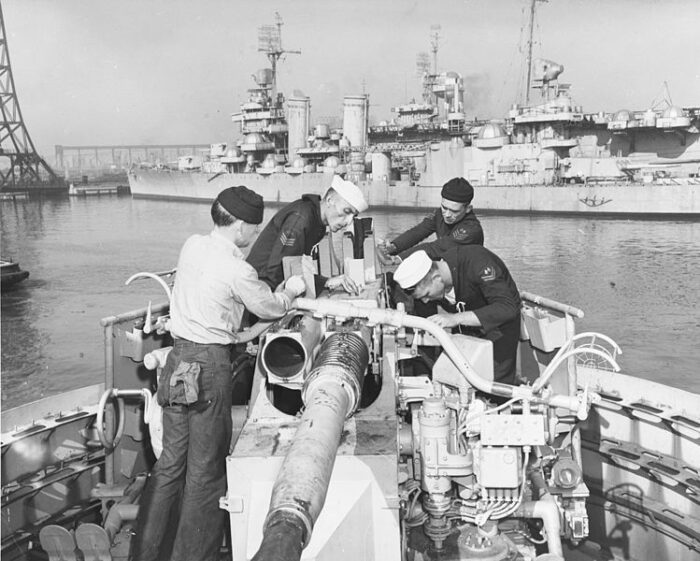
Brazilian sailors learning to maintain a Bofors gun mount onboard Barroso in Philadelphia 27 March 1941
This was basically the unchanged “panoply” of their 1945 armament suite:
Five triple 152mm or 6 inches 47 caliber Mk 16
Eight single 127mm or 5 inches 25 caliber Mk 27
Four quadruple 40mm/56 Mk 2 Bofors and six twin- 40/56 Mk 1 Bofors
Ten (Barroso) or eight (Tamandaré) twin 20mm/70 Mk 24 Oerlikon AA guns
The biggest change was on Tamandaré on which her entire secondary 5-inches/25 battery was replaced by four twin 127mm/38 or 5 inches Mk 29 gun turrets placed on the upper deck platforms, a considerable increase in firepower. The secondary gunhouses were protected by between 32 and 25 mm or 2.5 to 2 inches armour.
Sensors
When transferred in 1951 both cruisers diverged:
Barroso had an SK, SG, Mk 13, and two Mk 4 fire control radars.
Tamandaré had the SK-2, SG, Mk 8, 2x Mk 28 radars.
In the 1960s after their US refit, they lost their SK/SK-2 and SG models for SPS-10 and SPS-12 radars. Displays were also modernized.
In the 1970s however these cruisers were woefully under-equipped to face modern threats. An all gun suite was worthless against incoming missiles or jet aircraft.
They completely lacked any electronic countermreasure or chaff launchers, nor any sonar to detect distant submarines. They were completely dependent of recently acquired FRAM-II destroyers.
Between their massive crew of 900 and dubious survivability, as well as rising maintenace costs and lack of spare parts, no doubt Brazil considered there were better options before rremoving them from service in 1973-76.
Air Group
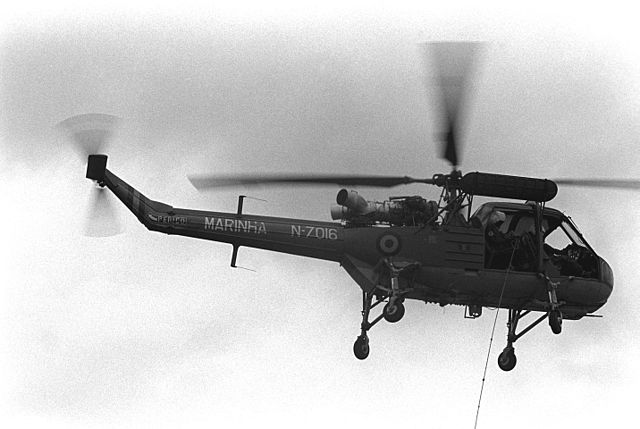
Both had an helipad installed at their poop. On bot the mainmast derricks and catapults were removed prior to the 1951 transfer. The hangar was able to accommodate two seaplanes, and now there were two helicopters with spare parts. They were well sheltered for easier maintenance. These helicopters were Westland UH-2 Wasp of the Aviação Naval.
⚙ specifications Barroso |
|
| Displacement | 9,800t or 10,560t standard, 12,700/13,500t FL |
| Dimensions | 608 x 68-69 ft or 185.4 x 21.2 x 6.94-7.37m full load |
| Propulsion | 4 sets Westinghouse GS turbines, 8 B&W boilers, 100,000 hp |
| Speed | 32.5 knots |
| Range | 10,000 nm at 15 knots |
| Armament | 5×3 6-in/47 Mk 16, see notes, 4×4 and 6×2 40mm/56 Mk 1/2, 8-10×2 20mm/70 Mk 24, |
| Protection | Belt 127mm, magazines 51-120mm, bulkheads 127mm, deck 51mm, barbettes 152 mm, turrets 165mm |
| Sensors | SK, SG, Mk 13, 2x Mk 4 radars (C11) or SK-2, SG, Mk 8, 2x Mk 28 radars (C12) |
| Air Group | 1 helicopter (+2 stored) |
| Crew | 868 |
Career of the Barroso class
 Almirante Barroso C-11
Almirante Barroso C-11
Barroso ship was acquired in 1951 together with Tamandaré, a more modernized version of the Brooklyn class. Barroso like her sister will take part in the “Lobster War”, a fishery dispute which degenerated into a standoff between the Brazilian and French Navies off the coast of northeastern Brazil in 1963. It was settled by treaty recoignising the right of Brazil to lobsters on its continental shelf. See the Brazilioan navy in the cold war for more details.
Barroso suffered accidents during her carrer in the Brazilian Navy, explosions and fire. On August 14, 1967, while underway training trip between Salvador and Rio de Janeiro with the Minister of the Navy Admiral Augusto Rademaker on board, one of her eight boilers exploded, causing 11 deaths. She remained at bay and was towed to Salvador by the tug Caboclo (V-19). She was patched and repairs here, and then at Rio later. Her career was far less active in the following years until she was deactivated on May 15, 1973 (MoD Notice nº 0423) after 22 years of service, not countng the prewar and WW2 years under US service. She was sold as scrap to Agrafer Comércio de Ferros e Metais Ltda., Diadema, dismantled in Santos, São Paulo.

Barroso underway off Rio de Janeiro Bay, 1960s
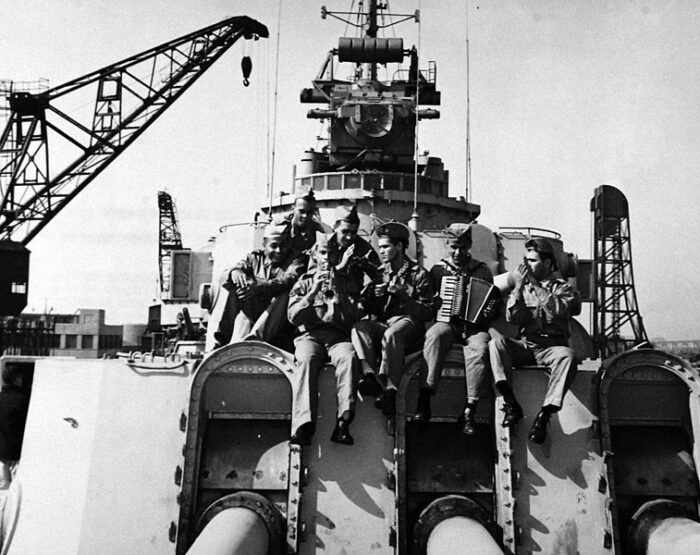
An improvized crew orchestra playing from her “A” turret, date unknown
 Almirante Tamandaré C-12
Almirante Tamandaré C-12

As the former USS Saint Louis acquired under the Military Assistance Program and Mutual Assistance Act, she was renamed after Joaquim Marques Lisboa, Marquis of Tamandaré, patron of the Navy. Both cruisers were most important additions to the Navy under the Getúlio Vargas administration (1951–1954) and replaced their Minas Geraes-class dreadnoughts, notably as prestige and flagships.
Tamandaré was shown ater a short overhaul to the Brazilian naval staff on January 29, 1951, and she incorporated on February 6, 1952 with ceremony held at the Philadelphia Naval Base. Captain Paulo Bosísio took command. She had exercises from February 13 to March 13 in Norfolk and gept back for fixes in Philadelphia before departing for Brazil on March 13, via Norfolk again, Port of Spain, Recife, Salvador and Búzios, and entering the Rio de Janeiro bay on April 20. There was a crowd to cheer her from the beaches and berths. She was greeted after berthed by sixteen Scottish bagpipes of the Marine Corps Marching Band, which granted the crew the National Flag.
In Brazilian service, the cruiser she sailed 216,096.7 miles, visited four continents. In the 1960s, she escorted the ex-British Colossus class aircraft carrier NAeL Minas Gerais.
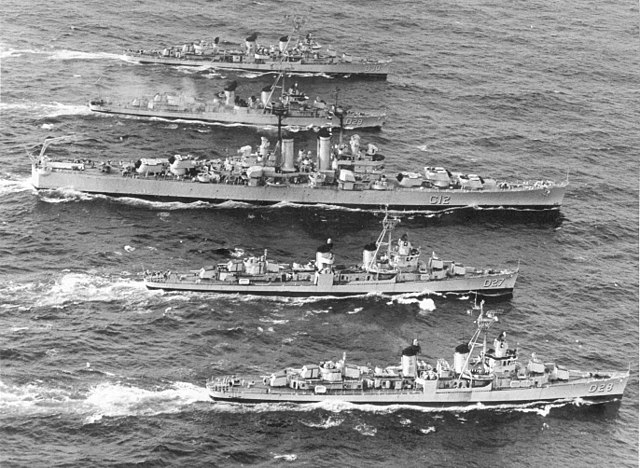
Tamandaré Escorted by the destroyers Pará, Paraíba, Paraná and Pernambuco during the 1963 Lobster War
During the 11 November “movement”, shots were fired from Army forts at Rio de Janeiro on several ship, notably Copacabana and Santa Cruz Fortress in Niterói. Tamandaré was however never hit. Se just pointed her main artillery on the Rio fort, which ceased fire and became silent, no side firing a single shot. Authorities onboard comprised President Carlos Luz, Carlos Lacerda, Prado Kelly and Colonels Jayme Portella and Jurandir Mamede. The event had been a pro-and anti-Getulist faction dispute. The ministers of the Navy and Air Force were against the movement, and by order of the Fleet CiC, Vice Admiral Carlos Pena Boto, all available ships including Tamandaré, were on standby. As troops arrived, Carlos Luz and part of his cabinet boarded Tamandaré under command of captain Sílvio Heck. Pena Boto transferred his flag to the cruise and prepared to sailto Santos, São Paulo. When it happened she was undergoing maintenance with only two boilers working, so she sailed at 8 knots.
The other faction feared a possible Navy operation and ordered the closing of Guanabara Bay to prevent their departure, and whe Tamandaré crossed the bar at 10:14 AM the Fort da Laje warned her with semaphore signals. She just ignored this warning and fired a blank shot in return. The Fort then started to fire on her, rather innacurately as she went her way out at sea. When Tamandaré passed the protection of Cotunduba Island she entered the area of the Copacabana Fort, which was also ordered to fire on her. Here too, all fell way short despite of the distance and it was later argued that the Army just wanted to scare the ship’s crew. They also knew full well than a returned fire could have been far more devastating on land. The forts’s guns were antiquated, whereas the curisers had an accurate, long range and rapid firing battery. Historians John W.F. Dulles and Hélio Silva still maintained the forts had an order to hit Tamandaré but this was not obeyed. Tamandaré all this time was on batle quarters with her gunners and fire control operators at the ready, waiting the order. The guns were loaded and aimed at the forts, but orders from Admiral Pena Boto and Carlos Luz never came.
Still she as shelled for 22 minutes and at some point, managed to maneuver behind an Italian ship blocked the fort’s field of fire. Later the rocky islet southeast of Copacabana Ilha Mãe received a few shells. Tamandaré crossed the channel between this islet and Ilha Pai and escaped at 11:15 am. She headed south to mislead its intentions, and then proceeded to Santos, Ponta do Boi, and the Island of São Sebastião. After five hours of work to restart other boilers she sailed at 16 knots. On November 12 they learned however the forts of Santos, was ordered to fire on her if she tried to dock. Both Pena Boto and Carlos Luz vetoed any fight and proposed to instead sail to Salvador. Soon it was learned the Army controlled the entire country. The Congress declared Carlos Luz’s impeachment so in the evening, 130 miles south of the coast of São Paulo, the admiral obeyed the new government and returned to Rio. The admiral ordered a life fire exercise notably to clear up the loaded guns as it was impossible to unload them manually. She was back at Rio de Janeiro on the morning of the 13th.[58]
In 1963, Tamandaré like Barroso took part along the rest of the Brazilian Fleet, t the “lobester war”, a standoff to the Brazilian Northeast, with the French National Navy. Tamandaré however could not proceed tdue to engine troubles and was instead towed to Salvador after an engine breakdown.
By the early 1970s, she was not only obsolete but also way too expensive to operate. Maintenance was still possible with parts from Barroso, decommissioned in 1973. There were also plan to modernize her with British Sea Cat and Exocet missiles. However, the new ASW frigates and submarines had all prioritiy and there was just no budget allocated. By June 28, 1976, after 24 years of service she had a decommissioning ceremony, after the MoD note of April 12, 1976. She was still mothbvall for an emergency reactivation until 1980.
On August 5, 1980, she was solf for BU. Auctioned off by Superwinton Enterprises Inc. for US$1,100,000 (on thirty of her 1951 acquisition cost) she was sold to a Taiwanese shipbreaker. She was towed there given her engines were inoperative, and during transit, she encountered heavy weather and started to list sharply. A repair team visited her and judged it was still possible in Capetown. However on 24 August 1980 she sank rapidly while underway, and the towline was dropped. Her final resting place is not far from the Cape.
Read More/Src
Books
Bonner, Kermit (1996). Final Voyages. Paducah: Turner Publishing Company.
Carloni, Karla G. (julho–dezembro de 2009). «O 11 de Novembro de 1955». Universidade Federal de Juiz de Fora.
Diretoria de Patrimônio Histórico e Documentação da Marinha. «Cruzador Tamandaré (1952-1976)»
Domagalski, John J. (2012). Sunk in Kula Gulf: The Final Voyage of the USS Helena and the Incredible Story of Her Survivors in World War II. Potomac Books
Dulles, John W. F. (2014). Unrest in Brazil: Political-Military Crises 1955-1964. Austin: University of Texas Press
«Incorporado à Armada o cruzador “Tamandaré”». Folha da Manhã, Ano XXVII, seção Economia e Finanças
«Itamarati:cabe à França a tarefa de reabrir negociações». Folha de S. Paulo, ano XLII
Frank, Richard B. (1990). Guadalcanal: The Definitive Account of the Landmark Battle. Marmondsworth: Penguin Books.
Friedman, Norman (1980). «United States of America». In: Gardiner; Chesneau. Conway’s All the World’s Fighting Ships 1922–1946.
Friedman, Norman (1984). U.S. Cruisers: An Illustrated Design History. Annapolis: US Naval Institute Press.
Higuchi, Hélio (1 de fevereiro de 2023). «”Lucky Lou”, o último cruzador Brasileiro». Tecnologia & Defesa
Lustoza, Paulo Marcos (26 de agosto de 2022). «A baixa do Cruzador “Tamandaré”». Revista do Clube Naval (401)
«Journal of the World Ship Society». London: World Ship Society. Marine News. 58. 2004.
Morison, Samuel Eliot (1958). Breaking the Bismarcks Barrier. 6. [S.l.]: Castle Books.
Naval Historical Division (1959). Dictionary of American Naval Fighting Ships. I. Washington: Naval History Division.
Rose, R. S. (2005). The Unpast: Elite Violence and Social Control in Brazil, 1954–2000. Ohio University Press.
Silva, Hélio (1985). O poder militar 2ª ed. Porto Alegre: L&PM
Terzibaschitsch, Stefan (1988). Cruisers of the US Navy 1922–1962.
Waldmann Júnior, Ludolf (2013). Tecnologia naval e política: o caso da Marinha Brasileira na era dos contratorpedeiros, 1942-1970
Links
http://portaldeperiodicos.marinha.mil.br/index.php/clubenaval/article/view/3167
https://web.archive.org/web/20160304182033/http://regobarros.eng.br/tamandare/index2.htm
https://www.marinha.mil.br/
https://web.archive.org/web/20160303224919/http://www.regobarros.eng.br/tamandare/
https://www.navypedia.org/ships/brazil/br_cr_barroso.htm
https://pt.wikipedia.org/wiki/C_Tamandar%C3%A9_(C-12)

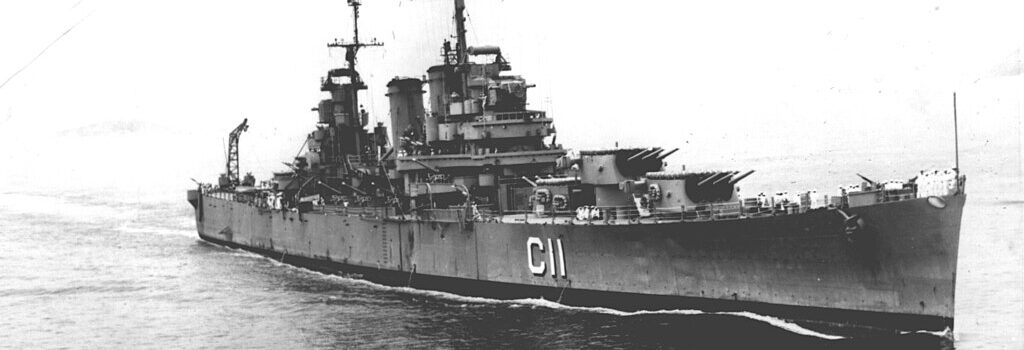

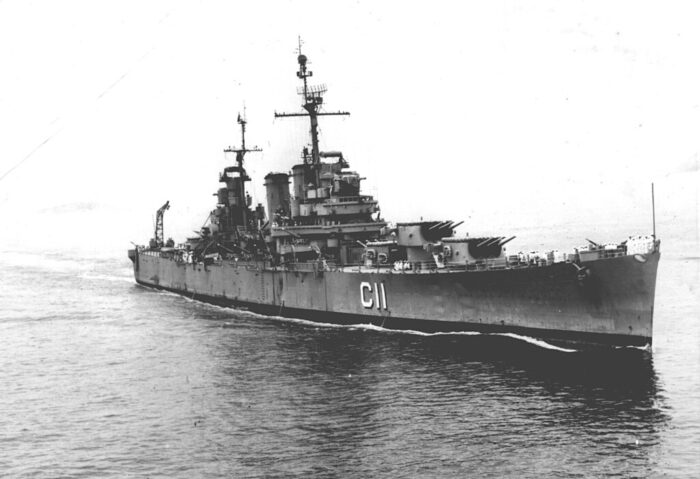
 Latest Facebook Entry -
Latest Facebook Entry -  X(Tweeter) Naval Encyclopedia's deck archive
X(Tweeter) Naval Encyclopedia's deck archive Instagram (@navalencyc)
Instagram (@navalencyc)





 French Navy
French Navy Royal Navy
Royal Navy Russian Navy
Russian Navy Armada Espanola
Armada Espanola Austrian Navy
Austrian Navy K.u.K. Kriegsmarine
K.u.K. Kriegsmarine Dansk Marine
Dansk Marine Nautiko Hellenon
Nautiko Hellenon Koninklije Marine 1870
Koninklije Marine 1870 Marinha do Brasil
Marinha do Brasil Osmanlı Donanması
Osmanlı Donanması Marina Do Peru
Marina Do Peru Marinha do Portugal
Marinha do Portugal Regia Marina 1870
Regia Marina 1870 Nihhon Kaigun 1870
Nihhon Kaigun 1870 Preußische Marine 1870
Preußische Marine 1870 Russkiy Flot 1870
Russkiy Flot 1870 Svenska marinen
Svenska marinen Søværnet
Søværnet Union Navy
Union Navy Confederate Navy
Confederate Navy Armada de Argentina
Armada de Argentina Imperial Chinese Navy
Imperial Chinese Navy Marinha do Portugal
Marinha do Portugal Mexico
Mexico Kaiserliche Marine
Kaiserliche Marine 1898 US Navy
1898 US Navy Sovietskiy Flot
Sovietskiy Flot Royal Canadian Navy
Royal Canadian Navy Royal Australian Navy
Royal Australian Navy RNZN Fleet
RNZN Fleet Chinese Navy 1937
Chinese Navy 1937 Kriegsmarine
Kriegsmarine Chilean Navy
Chilean Navy Danish Navy
Danish Navy Finnish Navy
Finnish Navy Hellenic Navy
Hellenic Navy Polish Navy
Polish Navy Romanian Navy
Romanian Navy Turkish Navy
Turkish Navy Royal Yugoslav Navy
Royal Yugoslav Navy Royal Thai Navy
Royal Thai Navy Minor Navies
Minor Navies Albania
Albania Austria
Austria Belgium
Belgium Columbia
Columbia Costa Rica
Costa Rica Cuba
Cuba Czechoslovakia
Czechoslovakia Dominican Republic
Dominican Republic Haiti
Haiti Hungary
Hungary Honduras
Honduras Estonia
Estonia Iceland
Iceland Eire
Eire Equador
Equador Iran
Iran Iraq
Iraq Latvia
Latvia Liberia
Liberia Lithuania
Lithuania Mandchukuo
Mandchukuo Morocco
Morocco Nicaragua
Nicaragua Persia
Persia San Salvador
San Salvador Sarawak
Sarawak Uruguay
Uruguay Venezuela
Venezuela Zanzibar
Zanzibar Warsaw Pact Navies
Warsaw Pact Navies Bulgaria
Bulgaria Hungary
Hungary

 Bundesmarine
Bundesmarine Dutch Navy
Dutch Navy Hellenic Navy
Hellenic Navy Marina Militare
Marina Militare Yugoslav Navy
Yugoslav Navy Chinese Navy
Chinese Navy Indian Navy
Indian Navy Indonesian Navy
Indonesian Navy JMSDF
JMSDF North Korean Navy
North Korean Navy Pakistani Navy
Pakistani Navy Philippines Navy
Philippines Navy ROKN
ROKN Rep. of Singapore Navy
Rep. of Singapore Navy Taiwanese Navy
Taiwanese Navy IDF Navy
IDF Navy Saudi Navy
Saudi Navy Royal New Zealand Navy
Royal New Zealand Navy Egyptian Navy
Egyptian Navy South African Navy
South African Navy






























 Ukrainian Navy
Ukrainian Navy dbodesign
dbodesign